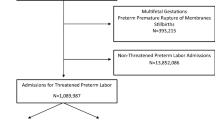Abstract
Objective: To determine whether early maternal discharge increases newborn readmission rates.
Methods: Singleton vaginal deliveries weighing at least 2500 grams were extracted from April 1, 1997 to March 31, 2000 Alberta hospital abstracts and linked to records of birth. Potentially preventable readmissions were for dehydration, jaundice, feeding problems, inadequate weight gain, and social reasons.
Results: The most common reason for readmission is jaundice (74%). In order of importance, influencing factors were: length of gestation, Aboriginal treaty status, first live birth, delivering in region of residence, number of deliveries done in the hospital, newborn sex, maternal smoking, birthweight, previous abortions, and delivering in nearest hospital. Post-delivery length of stay was associated with readmissions in the first 6 days post discharge (25% greater in those <27 hours compared to those >48 hours) but not in the first 28 days post discharge.
Conclusion: Early maternal discharge is a minor determinant of potentially preventable newborn readmissions.
Résumé
Objectif: Déterminer si le congé précoce après l’accouchement accroît le taux de réadmission des nouveau-nés.
Méthode: Nous avons extrait des registres d’hôpitaux albertains les dossiers d’accouchements simples par voie vaginale où le nouveau-né pesait au moins 2 500 grammes, pour la période du 1er avril 1997 au 31 mars 2000, et nous les avons couplés à l’ensemble des naissances enregistrées. Les réadmissions évitables étaient des cas de déshydratation, de jaunisse, de problèmes d’alimentation, de gain de poids insuffisant et de problèmes d’ordre social.
Résultats: Le motif de réadmission le plus commun était la jaunisse (74 %). Les facteurs déterminants, par ordre d’importance, étaient la durée de la grossesse, le statut d’autochtone visé par un traité, la naissance d’un premier enfant vivant, l’accouchement dans la région de résidence, le nombre d’accouchements à l’hôpital, le sexe du nouveau-né, le tabagisme maternel, le poids à la naissance, les avortements antérieurs et l’accouchement à l’hôpital le plus proche. La durée d’hospitalisation après l’accouchement était associée aux réadmissions durant les six premiers jours suivant le congé (les réadmissions après un séjour de moins de 27 heures étaient de 25 % supérieures aux réadmissions après un séjour de plus de 48 heures), mais pas aux réadmissions durant les 28 premiers jours suivant le congé.
Conclusion: Le congé précoce des mères après la naissance est un déterminant mineur des réadmissions évitables de nouveau-nés.
Similar content being viewed by others
References
Fetus and Newborn Committee, Canadian Pediatric Society and Fetal Medicine Committee, Society of Obstetricians and Gynecologists of Canada. Facilitating discharge home following a normal term birth: A joint statement with the Society of Obstetricians and Gynecologists of Canada. Paediatr Child Health 1996;1:165–68.
Wen SW, Liu S, Marcoux S, Fowler D. Trends and variations in length of hospital stay for childbirth in Canada. CMAJ 1998;158:875–78.
Lock M, Ray, JG. Higher neonatal morbidity after routine early hospital discharge: Are we sending newborns home too early? CMAJ 1999;161:249–53.
Lee KS, Perlman M, Ballantyne M, Elliot I, To T. Association between duration of neonatal hospital stay and readmission rate. J Pediatr 1995;127:758–66.
Oberer D, Aucherman L. Best practice: Clinical pathways for uncomplicated births. Best Pract Benchmarking Health 1996;1:43–50.
Eidelman, AI. Early discharge-early trouble. J Perinatol 1992;12:101–2.
Coody D, Yetman R, Montgomery D, Van Eys J. Early discharge and the timing of newborn metabolic screening. Clin Pediatr 1993;32:463–66.
Parisi VM, Meyer, BA. To stay or not to stay? That is the question. N Engl J Med 1995;333:1635–37.
Edmonson MB, Stoddard JJ, Owens LM. Hospital readmission with feeding-related problems after early postpartum discharge of normal newborns. JAMA 1997;378:299–303.
Liu LL, Clemens CJ, Shay DK, Davis RL, Novack, AH. The safety of newborn early discharge. JAMA 1997;278:293–98.
American Academy of Pediatrics, American College of Obstetricians and Gynecologists. Postpartum and Follow-up care. Guidelines for Perinatal Care 4th ed. Washington, DC: American College of Obstetricians and Gynecologists, 1997;142–82.
Brumfield, CG. Early postpartum discharge. Clinical Obstetrics Gynecology 1998;41:611–25.
Norr KF, Nacion K. Outcomes of postpartum early discharge,1960–1986: A comparative review. Birth 1987;14:135–41.
Grullon KE, Grimes, DA. The safety of early postpartum discharge: A review and critique. Obstet Gynecol 1997;90:860–65.
Carty EM, Bradley, CF. A randomized controlled evaluation of early postpartum hospital discharge. Birth 1990;17:199–204.
Waldenstrom U, Sundelin C, Lindmark G. Early and late discharge after hospital birth: Breastfeeding. Acta Paediatr Scand 1987;76:727–32.
Brooten D, Roncoli M, Finkler S, Arnold L, Cohen A, Mennuti M. A randomized trial of early discharge and home follow-up of women having a cesarean birth. Obstet Gynecol 1994;84:832–38.
Catz C, Hanson JW, Simpson L, Yaffe S. Summary of workshop: Early discharge and neonatal hyperbilirubinemia. Pediatrics 1995;96:743–44.
Brumfield CG, Nelson KG, Stotser D, Yarbaugh D, Patterson P, Spaybery, NK. 24-hour motherinfant discharge with a follow-up home health visit: Results in a selected Medicaid population. Obstet Gynecol 1996;88:544–48.
Kotagal UR, Atherton HD, Eshett R, Schoettker PJ, Perlstein, PH. Safety of early discharge for medicaid newborns. JAMA 1999;282:1150–56.
Margolis LH, Kotelchuck M, Chang, HY. Factors associated with early maternal postpartum discharge for hospital. Arch Pediatr Adolesc Med 1997;151:466–72.
Calhoun BC, Gries D, Barfield W, Kovac C, Hume R. Cost consequences of implementation of an early obstetrical discharge programme in a military teaching hospital. Aust N Z J Obstet Gynaecol 1999;39:1–35.
Braveman P, Kessel W, Egerter S, Richmond J. Early discharge and evidence based practice. JAMA 1997;227:334–36.
Margolid, LH. A critical review of studies of newborn discharge timing. Clinical Pediatrics 1995;34:626–34.
Inturrisi M, Lambert L. Length of stay for uncomplicated vaginal birth: A perinatal continuous quality improvement project. J Perinat Neonat Nurs 1998;12:11–22.
Author information
Authors and Affiliations
Corresponding author
Additional information
Acknowledgements: This work was partially supported by the Alberta Center for Health Service Utilization Research. The opinions and conclusions expressed in this paper are those of the authors and no endorsement by the Alberta Ministry of Health & Wellness is implied.
Rights and permissions
About this article
Cite this article
Johnson, D., Jin, Y. & Truman, C. Early Discharge of Alberta Mothers Post-delivery and the Relationship to Potentially Preventable Newborn Readmissions. Can J Public Health 93, 276–280 (2002). https://doi.org/10.1007/BF03405016
Received:
Accepted:
Published:
Issue Date:
DOI: https://doi.org/10.1007/BF03405016




